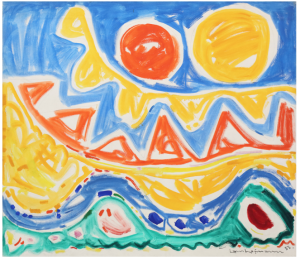255 Worth Avenue
Palm Beach, FL 33480
T 561.328.9504
Lisa@borghi.org
Hans Hofmann : A Retrospective
November 2, 2014– December 31, 2014
-

Hans Hofmann (1880-1966) Blue Arcata, 1955 Oil on canvas
Hans Hofmann : A Retrospective
A survey of the work, theory, and teachings of Hans Hofmann.
The only artist of the New York school to participate directly in European modernism, Hans Hofmann became known as the major exponent of Abstract Expressionism. His paintings are known for their manic, exuberant energy. Among 20th-century masters, he was the first to consolidate and codify the lessons of modernism into a teaching system. Well-known students of Hofmann’s include Helen Frankenthaler, Jane Freilicher, Wolf Kahn, Larry Rivers, and Nell Blaine.
Hans Hofmann began his career by visiting Paris’s thriving art scene, meeting such artists as Pablo Picasso, Henri Matisse and Georges Braque and Robert Delaunay. During this period, the work Hofmann created followed the leading avant-garde movement of the time—cubism. In 1910, Hofmann had his first solo show in Berlin. Living back in Germany at the start of World War I, Hofmann was excused from military service because of an earlier respiratory condition. Unable to return to France during the war, he opened an art school in Munich in 1915. Over the years, Hofmann earned a stellar reputation as an instructor of art. Worth Ryder, a former student, invited Hofmann to teach in the United States for the summer of 1930. Germany’s changing political climate made Hofmann decide to permanently settle in the United States in 1932. Hofmann based himself in New York City, where he worked as an instructor at the Art Students League before establishing his own school in the city. In 1934, Hofmann began a summer program in Provincetown, Massachusetts. Becoming known for his abstract paintings, Hofmann landed a solo exhibition at Peggy Guggenheim’s Art of This Century gallery in 1944. In 1957, his work was the subject of a retrospective showing at New York’s Whitney Museum of American Art. The next year, Hofmann retired from teaching in order to focus on creating art. Hofmann was selected to represent the United States at the Venice Biennale in 1960, alongside Philip Guston, Franz Kline and Theodore Roszak. By then, he was considered a leading abstract expressionist who created vivid and inventive paintings. In 1963, the Museum of Modern Art mounted a major exhibition of his work.
